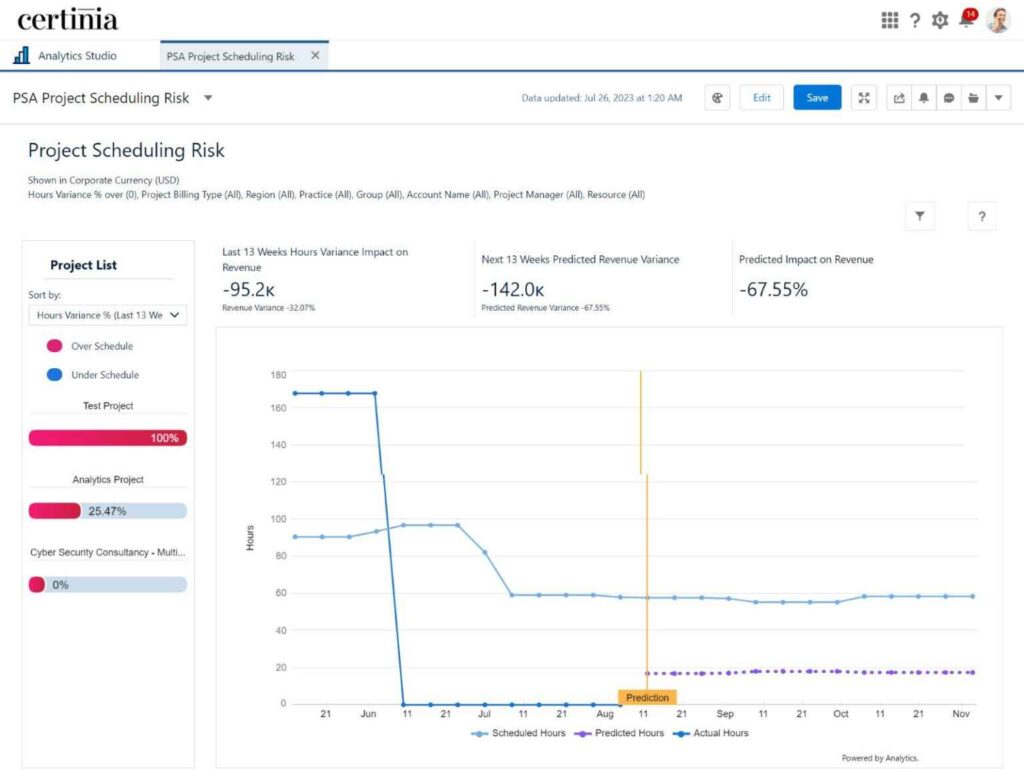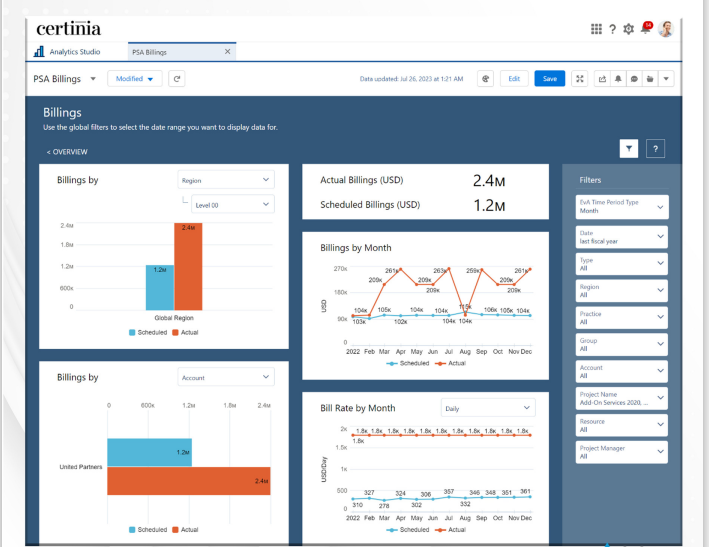It is high time for professional services organizations to regain command over their teams and projects. The emphasis is on augmenting project visibility across the portfolio and strategically deploying talent to amplify productivity & efficiency. That is exactly what Certinia PSA allows you to do. In this blog, we’ll learn about two potential Certinia PSA AI use cases, exploring their roles in automation, data analysis, decision support, and more.
Why Certinia PSA is Better Than Standard Automation?
Standard automation follows predetermined rules for repetitive tasks, lacking the adaptability and intelligence of advanced technologies like Artificial Intelligence.
Certinia PSA surpasses standard automation by offering a more sophisticated and adaptable solution for professional services. Unlike standard automation, Certinia PSA integrates Pragmatic AI and advanced analytics, providing a dynamic and intelligent approach to project and resource management. Certinia PSA excels in handling complex human-centric tasks, diverse skill sets, and the intricacies of professional services, offering more flexibility and precision. It goes beyond the limitations of traditional rule-based automation, ensuring organizations can optimize resources, enhance decision-making, and achieve superior efficiency in managing their projects.
Now, let’s explore the fundamentals of Pragmatic AI and Predictive Analytics.
Understanding the Differences: Pragmatic AI vs. Predictive Analytics
| Aspect | Pragmatic AI | Predictive Analytics |
| Focus | Primarily on Automation | Primarily on Future Trends |
| Decision-Making | Emphasizes Real-Time Decisions | Analyzes Historical Data for Insights |
| Implementation | User-Friendly, Practical | Complex, May Require Data Scientists |
| Solutions | Problem-Specific, Immediate Impact | Strategic Planning, Long-Term Forecasting |
| Adaptability | Prioritizes Adaptability, Suitable for Diverse Industries | Industry-Specific, Relies on Historical Data |
Choosing the Right Approach:
- For Immediate Impact: Pragmatic AI is preferable when immediate, practical results are crucial.
- Long-Term Strategy: Predictive Analytics is ideal for organizations focusing on long-term planning and foreseeing future trends.
- Balanced Approach: Combining both Pragmatic AI and Predictive Analytics can offer a comprehensive solution, addressing immediate needs while preparing for the future.
Certinia PSA: Three AI Use-Cases of Resource Management and Project Planning
This section effectively illustrates the role of Pragmatic AI, Predictive Analytics, and Dashboards in enhancing project and resource management capabilities in Certinia PSA. Here are two potential AI use cases for each aspect of Certinia Professional Services Automation (PSA):
1. Resource Management
Resource Management in Certinia PSA involves efficiently allocating and utilizing human resources to meet project demands. It encompasses skills tracking, capacity planning, and workforce optimization. Certinia PSA’s Resource Management tools enable organizations to match the right skills with project requirements, ensuring optimal utilization of their workforce.
a. How Pragmatic AI Works in Resource Allocation?
- Data Analysis: Certinia PSA uses Pragmatic AI to analyze historical project data, employee skills, and preferences.
- Resource Recommendations: Pragmatic AI algorithms provide intelligent recommendations for resource allocation based on the analyzed data.
- Real-Time Adjustments: The system continuously learns from ongoing project activities, adapting and making real-time adjustments to optimize resource allocation with the power of Pragmatic AI.
USE CASE 1:
IT Services Company Flies with Pragmatic AI: From Near-Disaster to Deadline Triumph
The Challenge: Project Phoenix, a critical deal for a major IT services company, loomed with a tight deadline and simmering chaos. Internal silos, shifting client needs, and an unpredictable market threatened to crash the project, impacting both profits and reputation.
The Traditional Path: The leadership, relying on experience and gut feeling, shuffled schedules, reassigned staff, and tried to appease the client. But these reactive measures only added confusion, fueling the fear of a potential disaster.
The AI Intervention: Taking a proactive stance, the company embraced Pragmatic AI with Certinia PSA. AI algorithms analyzed:
- Project data: performance metrics, resource allocation, task completion rates.
- Team dynamics: collaboration patterns, communication channels, individual skills.
- Industry trends: emerging technologies, market shifts, competitor insights.
The Results: Armed with these data-driven insights, the leadership made precise decisions:
- Targeted resource reallocation: Underutilized talent shifted to critical areas.
- Streamlined communication: Silos broken down; clear channels established.
- Predictive risk management: Potential roadblocks identified and addressed proactively.
The Impact: Project Phoenix soared through its final weeks, exceeding client expectations and hitting the deadline. More than just timely delivery, the success brought:
- Increased team morale and productivity
- Enhanced client satisfaction
- Boosted reputation and credibility
c. Dashboard Used: Certinia PSA Skills Capacity and Demand Planning Dashboard
This dashboard allows you to observe available capacity categorized by skill/certification, utilizing data extracted from Project Reporting, Utilization Results, and Resource Skills datasets. It is specifically designed for integration into the PSA Resource Management workspace.
12 Effective PSA Dashboards for Your Business
This eBook Will Cover
- Benefits of using PSA Dashboards for organizations.
- How Certinia PSA addresses the typical reporting challenges faced by boards.
- Step-by-step process to create a report in Certinia PSA.
- Learn about Certinia PSA Dashboards: Overview, Best Practices, and 12 PSA Dashboards.
Data presented in this dashboard can assist in addressing both operational and strategic business inquiries, such as:
- Are the available resources equipped with the necessary skillsets for successful project delivery?
- Do your resources possess the required skills to meet the current demand?
- What is the number of resources available for a specific skill set, and what is their availability?
- Is it advisable to meet the demand through internal or external resources?
- Where should you prioritize investments for long-term development and growth, guided by reporting trends?

2. Project Planning & Scheduling
Project Planning & Scheduling in Certinia PSA focuses on creating and optimizing project timelines. It involves analyzing historical project data, identifying dependencies, and utilizing Pragmatic AI-enhanced scheduling to ensure efficient project execution. Certinia PSA’s tools aid in adaptive scheduling, real-time adjustments, and predictive analytics, allowing organizations to deliver projects on time and adapt to changing circumstances.
a. How Pragmatic AI Works in Project Scheduling?
- Historical Project Data Analysis: Pragmatic AI algorithms analyze past project data to identify patterns, dependencies, and potential risks.
- Optimized Scheduling: Certinia PSA utilizes Pragmatic AI to optimize project schedules by considering historical data, resource availability, and task dependencies.
- Adaptive Scheduling: The system adapts schedules based on real-time changes, ensuring flexibility and responsiveness to evolving project needs.
USE CASE 2:
Building Brighter with Bytes: How a Small Team Took a Big Leap with AI
The Challenge: A small construction company, fueled by ambition, embarked on a project beyond its usual scale. Yet, tight deadlines, tangled dependencies, and unpredictable weather threatened to turn their brick-and-mortar masterpiece into a pile of dust.
The Traditional Path: Relying on experience and intuition, the project manager juggled schedules, stretched resources, and prayed for good weather. But each unforeseen snag chipped away at morale, budget, and timelines.
The AI Intervention: Recognizing the need for a smarter approach, the team embraced Pragmatic AI. AI algorithms mined a treasure trove of data:
- Past project data: Lessons learned from previous builds, resource demands, and unexpected hurdles.
- Real-time resource availability: Tracking personnel, equipment, and materials to pinpoint potential shortages.
- External factors: Weather patterns, material delivery timelines, and economic fluctuations.
The Result: Armed with this foresight, the project manager became a proactive maestro:
- Preallocated resources: Ensuring the right tools and people were in place before tasks began.
- Contingency plans activated: Weather delays tackled with pre-built solutions, minimizing downtime.
- Risks mitigated: Proactive interventions prevented minor hiccups from becoming major setbacks.
The Impact: The company not only met its deadlines but also:
- Boosted team morale and confidence.
- Minimized budget overruns and resource waste.
- Secured investor trust and future project opportunities.
c. Dashboard Used: PSA Project Scheduling Risk Dashboard with Project Revenue Representation
This dashboard allows you to observe a prioritized list of your projects, identifying those most susceptible to exceeding or falling short of schedule based on the hour variance percentage. It also forecasts potential schedule risks for the upcoming 13 weeks by analyzing the hour variance for each resource over the past 13 weeks. Additionally, the dashboard offers perspectives on revenue and costs, with calculations adjusted based on your selection.
Data presented in this dashboard helps in analyzing trends and making crucial business decisions, including:
- Quickly prioritize projects with the highest variance or significant impact on revenue.
- Monitor changes in hour variance over the last 13 weeks for problematic projects.
- Anticipate hour variance in the next 13 weeks based on the past 13 weeks.
- Implement necessary measures to address future hour variance and minimize its impact on project revenue.

NOTE: It’s important to note that the specific AI capabilities and features may vary based on the version of Certinia PSA and any updates released after my last knowledge update. Always refer to the latest documentation, release notes, or contact Certinia directly for the most accurate and detailed information on Pragmatic AI leverage within Certinia PSA.
3. Accurate Project Billings
The PSA Project Billings is useful for billable projects and helps to identify billing data that includes information on business records like budget, expense, milestones, miscellaneous adjustments and timecards. Using this tool, businesses can get the data for the current fiscal quarter, track the historical actual billings data, view KPIs for scheduled billings and actual billings and compare the billing data. Certinia AI-powered PSA billing automates billing events reducing the need for manual intervention and minimizing risks associated with delayed project deliveries.
How Pragmatic AI works in Project Billing?
Identify billing patterns- Pragmatic AI analyzes historical billing patterns to predict delays or risks in future billing cycles. This helps project managers take prompt action ensuring project stability.
Detect Potential Risks- Pragmatic AI identifies potential risks arising from disputed billings and addresses those with proactive strategies before they escalate and affect cash flow.
Real Time Insights- Leveraging AI, project managers can get insights into late billing reasons and resolve it efficiently streamlining processes. This allows quick issue resolution and improves billing efficiency.
Use Case 3:
Harnessing AI for Accurate Billing and Cash Flow: A Consulting Firm’s Success Story
A mid-sized consulting firm handling several client projects simultaneously faced challenges with accurate and timely billing and invoicing. Manual tracking of billable hours, project deadlines and overhead expenses resulted in billing errors, extended payment cycles and missed revenue opportunities. The finance teams struggled to reduce billing complexities and maintain a steady cash flow across multiple billable projects.
The Traditional Path
The firm followed the traditional approach and manually processed the billing cycle using the data shared by project managers and consultants. This led to errors, discrepancies, unbilled hours, and invoice delays causing cash flow disruptions.
The AI Intervention: The consulting firm leveraged Pragmatic AI in Certinia PSA that helped analyze the following data.
- Historical Data and Billing Patterns: Past billing cycles and payment history to uncover patterns like payment delays and discrepancies.
- Project Timelines and Billable Hours: Project timelines, milestones and logged billable hours to identify missed billable tasks.
- Client Payment Patterns: Client payment behavior and market trends to predict potential payment delays.
The Results: Armed with these insights, the firm tackled billing issues in a proactive manner.
- Automated Data Collection: Preventing possible errors, minimizing disputes and capturing all billable hours.
- Faster Billing and Invoicing: Automated invoicing to bridge gaps between project completion and billing.
- Reduced Administrative Tasks: Reduced time in manual billing, freeing up resources for strategic activities.
The Impact: Here’s what the consulting firm achieved with AI
- Accurate billing and consistent cash flow
- Improved client relationships and long-term partnerships
- Increased efficiency of financial operations
Dashboard Used: PSA Billings Dashboard
This dashboard displays the data from the billing dataset including information from multiple objects in PSA like Milestones, Expenses, Miscellaneous Adjustments, Budgets and timecards. This dashboard also shows the data for the current fiscal quarter and KPIs for scheduled and actual billings. The dashboard allows users to analyze historical actual billings data and compare actual and scheduled billing data for the same period.
Data presented by this dashboard optimzes the billing models, improves financial visibility and performance and enables the finance team to:
- Track the financial health of the enterprise
- Gain instant visibility to billing information
- Automation of billing data across different sources
- Identify unbillable hours and potential errors beforehand
- Reduce time from project completion to billing

The Bottom Line
In summary, Certinia PSA unveils two powerful AI applications: Resource Management and Project Planning. With Pragmatic AI-driven resource allocation, predictive analytics, and insightful dashboards, Certinia PSA empowers organizations to optimize project timelines and resource allocation.
AblyPro, as a Certinia Consulting Partner, stands ready to amplify these benefits, ensuring your journey with Certinia PSA is streamlined and strategically aligned.
Author

AVP, AblyPro

Murali is the AVP – Certinia at AblyPro with 12+ years of experience in handling complex Certinia and Salesforce applications, implementations, configurations, and customizations. At AblyPro, he has been the pillar of all the Certinia PSA and ERP project deliverables, ranging from design to implementation, project management, and resource management. With years of practical knowledge and expertise in this industry, Murali supports the sales team in strategizing customer solutions to meet the actual business needs of the clients. Murali is a dynamic and experienced professional with multiple Certinia and Salesforce certifications, helping businesses to technically strive in this ever-changing landscape.





